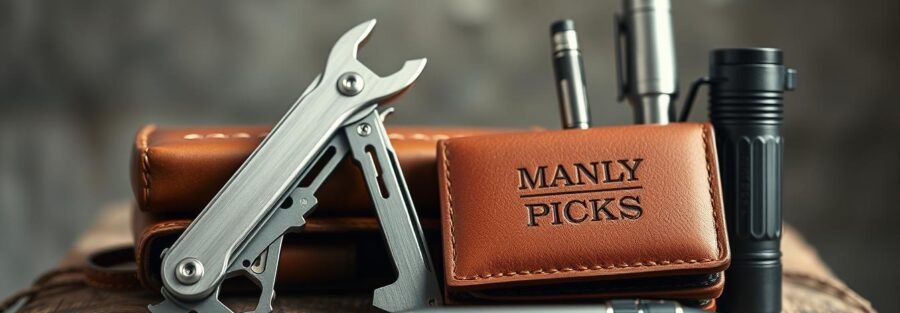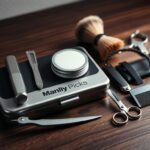Being prepared for the unexpected is a mindset that can significantly simplify your daily life. That’s where Everyday Carry (EDC) comes in – a practical approach to equipping yourself with essential tools that make a difference in both mundane tasks and unexpected situations.
A well-curated EDC kit is about utility, portability, and durability. It’s not just about carrying items; it’s about carrying the right items that provide maximum utility relative to their weight and cost. For instance, a reliable Kansept EDC knife can be a game-changer, offering a perfect blend of functionality and convenience.
The beauty of EDC lies in its personal nature. It’s about tailoring your kit to your lifestyle, environment, and needs. As we explore building your first EDC setup, we’ll cover essential tools, carrying methods, and budget considerations, ensuring you get started without unnecessary complexity or expense.
Key Takeaways
- Understand the core philosophy behind EDC and its focus on utility and preparedness.
- Learn how to tailor your EDC kit to your specific needs and environment.
- Discover essential tools and items to include in your first EDC setup.
- Get insights into effective carrying methods and budget-friendly options.
- Apply the “EDC Test” formula to evaluate items for your kit.
Understanding Everyday Carry: Philosophy and Purpose
Understanding EDC means grasping its core philosophy: utility, portability, and durability. At its core, EDC is guided by these three principles, ensuring that each item you carry has a clear purpose, is lightweight and easy to carry, and is robust enough to withstand daily use.
What is EDC and Why It Matters
Everyday Carry (EDC) is a deliberate selection of tools and items you carry daily to handle both routine tasks and unexpected situations. Everyone already has some form of EDC, such as a phone, wallet, and keys, but an intentional approach can significantly enhance your preparedness and efficiency. By thoughtfully choosing what you carry, you can improve your daily life and be better equipped to handle challenges.

The EDC Test: Balancing Utility, Weight, and Cost
The “EDC Test” formula, Carry + Cost , serves as a practical framework for evaluating whether an item deserves a place in your kit. This formula helps prevent overloading your pockets with items that aren’t worth their weight or cost. It’s about finding the right balance between being prepared and being practical—carrying what you need without being weighed down. Your EDC should be tailored to your specific needs, life, and environment, rather than following trends.
By applying the EDC Test, you can refine your everyday carry to include only items that enhance your efficiency and preparedness. This thoughtful approach to EDC ensures that you’re always ready without being burdened by unnecessary items.
Assessing Your EDC Needs
Assessing your EDC needs involves analyzing your daily routine, environment, and personal priorities. To build an effective EDC kit, you must understand what tasks you encounter daily and what tools you already carry.
Evaluating Your Daily Routine and Environment
Start by examining your daily routine and the environment in which you operate. Consider the tasks you perform regularly and the situations you find yourself in. Your environment, whether urban, suburban, or rural, plays a significant role in shaping your EDC choices.
- Identify the tasks you perform daily and the tools required for those tasks.
- Consider your existing carry items, such as your phone, wallet, and keys, as the foundation of your EDC system.
- Reflect on times when you’ve needed a tool you didn’t have, highlighting gaps in your current setup.
Identifying Your Personal Priorities
Once you’ve evaluated your daily routine and environment, it’s time to identify your personal priorities. This involves determining what items are essential to your daily life and what can be considered luxury items.
- Prioritize your needs based on frequency and importance, distinguishing between daily and occasional needs.
- Be honest about what you’re willing to carry consistently, as the best EDC is one you actually have with you when needed.
- Consider your “carry capacity” and work within your personal limits for comfort and practicality.

By following these steps, you can create an EDC kit that is tailored to your specific needs and lifestyle, ensuring that you’re always prepared for whatever the day may bring.
Essential EDC Components for Beginners
Building a solid EDC setup starts with understanding the essentials. Every day, we carry certain items that form the foundation of our EDC kit.
The Core Four: Wallet, Phone, Watch, and Keys
The “Core Four” – wallet, phone, watch, and keys – are items most people already carry. Optimizing these essentials is the first step in building a functional EDC kit. Your wallet is more than just a place to store cash; it’s a hub for your identification, credit cards, and other vital documents. Ensure it’s durable and organized.
Your phone is a critical component, serving as a communication device, navigation tool, and camera. Consider a phone case that offers protection without adding bulk. A watch can be both a fashion statement and a practical tool for keeping time. Keys are essential for accessing your home, vehicle, and other secured items. Consider a key organizer to keep them tidy and easily accessible.
Cutting Tools: Knives and Multitools

A quality cutting tool dramatically expands your capabilities for everyday tasks. From opening packages to handling emergencies, a reliable knife or multitool is indispensable. For beginners, a good EDC knife should be durable, easy to carry, and simple to use. The Kansept EDC knife is an excellent choice, offering exceptional quality and functionality.
Writing Implements: Practical Pens for Daily Use
A durable pen is often overlooked but is frequently needed for jotting down notes, signing documents, or leaving reminders. What makes a pen EDC-worthy? Durability, reliability, and size are key. Look for pens made from robust materials that can withstand daily wear and tear.
Light Sources: Compact Flashlights
A compact flashlight is worth carrying despite smartphone lights, offering superior brightness, runtime, and ergonomics. It’s invaluable for navigating dark spaces or finding lost items. When choosing a flashlight, consider its size, brightness, and battery life to ensure it meets your needs without being cumbersome.
For beginners, starting with these essential components is crucial before considering more specialized tools. The key is to select items that complement each other and work together as a system, addressing the most common daily needs while maintaining a minimal footprint in your pockets.
Choosing Your First EDC Knife
A quality EDC knife is the cornerstone of an effective everyday carry kit, offering versatility and utility. When selecting your first EDC knife, several factors come into play to ensure you choose a tool that meets your needs without being cumbersome or problematic.
Kansept EDC Knives: Premium Blades for Everyday Tasks
Kansept EDC knives stand out for their exceptional quality, materials, and craftsmanship, making them ideal for everyday carry tasks. Their premium blades are designed to offer durability and performance.

Understanding Blade Types and Materials
The type of blade and its material are crucial considerations. Common blade steels include stainless steel and high-carbon steel, each offering different benefits in terms of edge retention, corrosion resistance, and ease of sharpening. Understanding these properties helps in selecting a knife that suits your needs.
Legal Considerations for Carrying Knives
Before carrying a knife, it’s essential to understand local knife laws and regulations, including blade length restrictions and prohibited mechanisms. Ensuring your EDC knife complies with these laws is crucial to avoid legal issues.
When choosing your first EDC knife, consider the balance between utility and discretion. A good EDC knife should be effective without being intimidating or problematic in public settings. Folding knives are often preferred for EDC due to their convenience and reduced legal entanglements compared to fixed blades.
Key considerations include blade size, locking mechanism, opening method, and overall weight and bulk. By weighing these factors, you can select a knife that enhances your EDC setup without compromising on practicality or legality.
Everyday Carry Guide: How to Build Your First EDC Setup
Building your first EDC setup is a journey that requires thoughtfulness and practice. It’s about creating a kit that is tailored to your needs, lifestyle, and environment.

Starting Small: The Minimalist Approach
When starting your EDC journey, it’s crucial to begin with a minimalist approach. Focus on the essentials that you’ll use daily, such as a wallet, phone, keys, and a pocket knife. Avoid the temptation to carry everything at once. Instead, prioritize the tools that serve multiple purposes or are used frequently.
- Identify your core needs and prioritize items that fulfill them.
- Start with a basic kit and gradually expand based on your experiences.
- Consider the weight, utility, and cost of each item in your kit.
Testing and Refining Your Kit
Once you’ve assembled your initial EDC setup, it’s time to put it to the test. Carry it daily for a month, evaluating the performance of each item. Ask yourself: What tools do I use most? What feels unnecessary? What am I missing?
Use this feedback to refine your kit. Keep the items that prove their worth, replace or remove those that don’t add value, and identify gaps that need to be addressed.
Avoiding Common Beginner Mistakes
Beginners often make the mistake of carrying too much or choosing items that are impractical or prioritize aesthetics over function. To avoid these pitfalls, focus on the utility of each item and consider whether it justifies its place in your kit.
Be wary of “pocket jewelry” – items that look cool but lack real utility. Your EDC kit should be a practical collection of tools that enhance your daily life, not just a collection of fancy items.
By starting small, testing your kit, and avoiding common mistakes, you’ll be well on your way to building an EDC setup that truly serves your needs.
Carrying Methods and Organization
Mastering the art of EDC organization can significantly enhance your daily productivity. Effective EDC organization is not just about carrying the right items, but also about how you carry them.
Pocket Organization Strategies
When it comes to EDC, your pocket is your best friend. Most people have multiple pockets in their clothing, providing easy access to frequently used items. To maximize efficiency, it’s essential to develop a pocket organization strategy. This involves assigning specific items to specific pockets, a concept known as “pocket mapping.” By doing so, you build muscle memory, ensuring that you can quickly access your tools when needed.
Distributing weight evenly across your carry is also crucial to avoid discomfort and maintain a balanced, discreet profile. Organizing your items based on frequency of use is another effective strategy, with the most-used items being the most accessible.
EDC Bags, Pouches, and Organizers
For those who need to carry larger or more numerous items, EDC bags or pouches offer ample space and organization options. These are ideal for carrying additional gear that won’t fit comfortably in pockets. Specialized EDC organizers, such as key organizers and wallet/phone case combinations, can also maximize space efficiency, reducing bulk and enhancing accessibility.
Adapting your carry method to different clothing styles, seasons, and social/professional environments is key to maintaining a consistent and effective EDC setup. Whether you’re using a keychain or a dedicated EDC pouch, the principle remains the same: ensure that your items are organized and easily accessible.
Building a Practical EDC on Different Budgets
Creating an EDC kit that suits your needs doesn’t have to break the bank. The key is to start with the basics and gradually add more items as you become more comfortable with your EDC setup.
Budget-Friendly EDC Setups
For those on a tight budget, there are still plenty of options available. Look for affordable alternatives in essential categories like knives, lights, and pens. For example, a reliable EDC knife can be found for under $20. When building a budget-friendly EDC setup, focus on the most critical items and gradually upgrade as your budget allows.
| Item | Budget-Friendly Option | Premium Option |
|---|---|---|
| Knife | $15-$25 | $50-$100 |
| Flashlight | $10-$20 | $30-$50 |
| Pen | $5-$10 | $20-$50 |
Investment Pieces Worth the Splurge
While it’s possible to start with budget-friendly options, some EDC gear is worth investing in due to its durability and performance. For instance, a high-quality multitool or a premium flashlight can provide long-term value despite the higher initial cost. When choosing investment pieces, consider the potential long-term benefits and whether they align with your EDC setup needs.

Conclusion: Your EDC Journey
Starting your EDC journey with the right mindset is crucial for creating a setup that truly enhances your daily life. Your everyday carry is a personal journey that evolves with your lifestyle and needs, not a one-time decision. By focusing on utility, simplicity, quality, and personalization, you can build an EDC that makes a real difference.
Begin with a minimalist approach, test your setup in real-world situations, and refine it based on your actual needs. The best EDC is one you carry consistently, empowering you to handle life’s challenges with confidence and power. As you continue on your EDC journey, remember that it’s about self-reliance and problem-solving, having the right tool at the right time.



